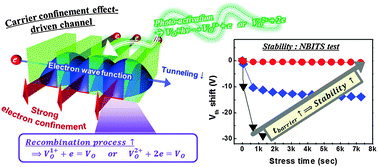Carrier confinement effect-driven channel design and achievement of robust electrical/photostability and high mobility in oxide thin-film transistors
Abstract
Oxide thin-film transistors (TFTs) with high electrical performance, high electrical/photostability, and low process temperature capabilities are required to realize next-generation display applications. However, commercially available oxide-based TFTs show a high degree of instability under simultaneous photoillumination and bias stress conditions, which is related to hole trapping, ambient interactions, and photo-ionization of oxygen vacancy defects. In this study, high performance, electrical/photostable oxide-based TFTs have been fabricated at low process temperatures (∼200 °C) using a carrier confinement effect-driven ZnO/Al2O3 superlattice channel structure. ZnO/Al2O3 superlattice structures drive high mobility (>25 cm2 V−1 s−1) by enhancing electrical conductivity along the planar direction. Moreover, the carrier confinement effect-driven channel structure promoted recombination events between photo-ionized oxygen vacancies and the photo-charged electrons due to effective carrier confinement, resulting in extremely high stability (ΔVth ≤ −0.7 V) under negative gate bias temperature illumination stress conditions, even at low process temperatures. Our channel design is a promising approach for producing highly photo-stable TFTs for next-generation displays.


 Please wait while we load your content...
Please wait while we load your content...